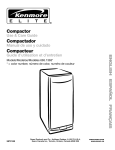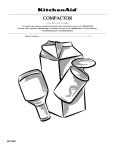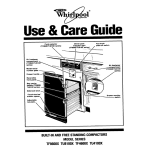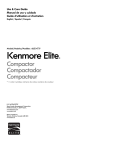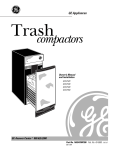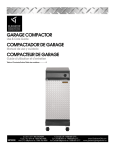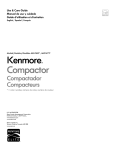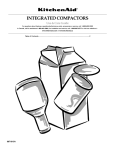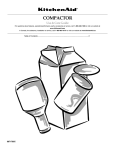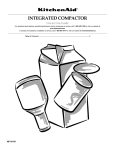Download Whirlpool Compactors Specifications
Transcript
COMPACTORS Table of Contents............2 For questions about features, operation/performance, parts accessories or service, call: 1-800-422-1230 In Canada, call for assistance: 1-800-461-5681, for installation and service call:1-800-807-6777 or visit our website at... www.kitchenaid.com or www.kitchenaid.com/canada MODELS: KUCC151 and KCCC151 9871628B TABLE OF CONTENTS Compactor Safety ..........................................................3 Electrical Requirements ................................................4 How Your Compactor Works ........................................4 Parts and Features..........................................................5 Installing Your Compactor ............................................6 Unpacking Your Compactor ..........................................6 Space Requirements ....................................................6 Freestanding and Undercounter Installation ..................7 Adjusting the Toe Plate..................................................9 Changing the Decorative Panel ....................................9 Using Your Compactor ................................................10 Using the Charcoal Air Filter........................................10 Starting Your Compactor ............................................11 Using Solid (Locked) Cycle ........................................11 Removing a Filled Bag ................................................12 Installing a New Bag....................................................12 Caring for Your Compactor..........................................13 Changing the Charcoal Air Filter ................................13 Cleaning Your Compactor ..........................................13 Troubleshooting ............................................................14 Assistance or Service ..................................................15 Warranty ........................................................................16 2 COMPACTOR SAFETY Your safety and the safety of others are very important. We have provided many important safety messages in this manual and on your appliance. Always read and obey all safety messages. This is the safety alert symbol. This symbol alerts you to potential hazards that can kill or hurt you and others. All safety messages will follow the safety alert symbol and either the word “DANGER” or “WARNING.” These words mean: You can be killed or seriously injured if you don't immediately follow instructions. You can be killed or seriously injured if you don't follow instructions. All safety messages will tell you what the potential hazard is, tell you how to reduce the chance of injury, and tell you what can happen if the instructions are not followed. IMPORTANT SAFETY INSTRUCTIONS WARNING: When using an electrical appliance, basic precautions should always be followed, including the following: ■ Read all instructions before using the compactor. ■ Close supervision is necessary when used by or near children. Do not allow to be used as a toy, or to run unattended at any time. Lock Key Switch when not in use and store key out of reach of children. ■ Do not compact toxic or volatile flammable material such as oily rags and insect sprays. Do not compact lighted cigarettes, cigars, or other hot or burning items. Do not overload the compactor. ■ Do not take apart the compactor. Incorrect reassembly can cause electric shock when subsequently used. ■ Do not touch moving parts. ■ Do not operate with a damaged cord set, plug, motor, or after damage in any manner. Have the compactor examined, repaired or adjusted by an authorized serviceperson. ■ Handle a loaded trash bag with care. Sharp objects can pierce the bag and cause injury. Do not overload trash bag with heavy material such as glass. ■ Use only for intended use as described in this manual. Do not use other than manufacturer's recommended attachments. ■ This compactor is intended for household use only. SAVE THESE INSTRUCTIONS 3 Electrical Requirements wWARNING How Your Compactor Works The compacting ram is the part of the compactor which compresses the trash. The compacting ram does not go to the bottom of the drawer. You will not see compacting of trash the first few times you load the compactor. NOTE: The compactor drawer should be about 1/2 full before the compactor can begin to compress the load. Electrical Shock Hazard You may hear a noise when glass breaks. Strong glass bottles may not break at all. Plug into a grounded 3 prong outlet. Do not remove ground prong. Do not use an adapter. Failure to follow these instructions can result in death, fire, or electrical shock. Recommended Grounding Method This compactor is for use on a single phase, 115-volt, 60 Hz, AC only 15 or 20 ampere fused and properly grounded circuit and is equipped with a grounding plug as shown below. Time delay fuse or circuit breaker is recommended. It is recommended that a separate circuit serving only this appliance be provided. In the event of an electrical short circuit, grounding reduces the risk of electric shock by providing an escape wire for the electric current. Do not modify the plug attached to the compactor; use only with a grounded receptacle. The trash in a full compactor bag will be about 1⁄4 the size of its original bulk. Load bulky trash, bottles, and cans in the center of the drawer. Bottles or cans not placed in the center may become caught between the ram and the drawer. The drawer monitor switch senses a “misload” and causes the ram to return to the “up” position without compacting. This compactor must be grounded while in use to reduce the risk of electric shock. The compactor is equipped with a three-conductor cord and three-prong grounding-type plug to fit the proper grounding-type receptacle. The green (or green and yellow) conductor in the cord is the grounding wire. Never connect the green (or green and yellow) wire to a live terminal. The outlet should be properly installed and grounded in accordance with the National Electrical Code and local codes and ordinances. No adapter should be used with this appliance. 4 PARTS AND FEATURES 7 1 OFF ON START ON AIR FILTER COM PACT SOLID (LOCK OFF ED) NORM AL TRASH) (ADD 2 8 3 9 4 10 5 6 11 1. Key-knob start switch 2. Charcoal air filter switch 3. Drawer handle 4. Model and serial number label 5. Wraparound panel 6. Touch-toe bar drawer opener 7. Compact switch 8. Activated charcoal air filter 9. Drawer monitor switch 10. Bag retainer buttons 11. Lever-action lock 5 INSTALLING YOUR COMPACTOR 3. Place two corner posts from carton on floor near compactor. Open compactor drawer and remove any shipping materials or other items shipped in the drawer. Do not remove the compactor bag (if installed). Grasp the handle and raise the front of drawer until it clears the drawer stops. Grasp sides of drawer and lift drawer out of compactor. Place the drawer on the two corner posts. IMPORTANT: Installer: Leave Use and Care Guide with the homeowner. Homeowner: Keep Use and Care Guide for future reference and for local electrical inspector’s use, if required. Unpacking Your Compactor 4. Place the other two corner posts on the floor to the side of the compactor. Grasp the sides of the compactor cabinet and put compactor on its side on top of the corner posts. Remove the shipping base from the bottom of compactor. wWARNING Excessive Weight Hazard Use two or more people to move and install compactor. Failure to do so can result in back or other injury. IMPORTANT: • Do not grasp console to move compactor. • Begin in the room where the compactor will be located. 1. Remove compactor from shipping carton. Remove all protective packaging materials such as tape and shipping pads. Remove waxy residue caused by protective shipping material with a mild solution of liquid household cleaner and water. 2. Check that power supply cord is attached to the cord clip on the rear of the compactor. leveling legs Space Requirements Check the location where your compactor will be installed. The cabinet opening should be square. You should be able to fully open the compactor drawer. Six inches (15.2 cm) of clearance is needed on the right side of compactor drawer to be able to remove compactor bag. Allow 23 inches (58.4 cm) in front of the compactor to remove drawer. Product dimensions cord clip The overall look of your compactor may vary. 341⁄8" (86.7 cm) 6 15" (38.1 cm) 24" (61 cm) Freestanding and Undercounter Installation Cutout dimensions NOTE: Proper installation is your responsibility. Make sure you have everything necessary for correct installation. It is the personal responsibility and obligation of the customer to contact a qualified installer to assure that electrical installation meets all national and local codes and ordinances. Grounded electrical outlet must be 3" (7.6 cm) min. from either side wall. Tools and materials needed for installation: 341⁄4" min. (87 cm) 18" min. (45.7 cm) 24" min. (61 cm) 151⁄4" min. (38.7 cm) Level Pliers Scissors Phillips screwdriver Flat-Blade screwdriver Utility knife Measuring tape 5 ⁄16" (8 mm)-Box-end wrench Gloves IMPORTANT: • Do not grasp console to move compactor. • Slide compactor onto cardboard or hardboard before moving compactor across floor to prevent damaging floor covering. • Do not allow the rear frame of the compactor to touch the floor covering when lifting or moving compactor. Clearance dimensions 6" (15.2 cm) clearance to the nearest vertical wall on the right side of compactor is needed to remove bag. Freestanding installation: 1. Use pliers to lower leveling legs away from cabinet. Place level inside on the floor of the cabinet. Check that the compactor is level from front to back and side to side. Adjust the leveling legs until the compactor is level. 23" (58.4 cm) clearance in front of the compactor is needed to fully open or remove compactor drawer. 2. Move the compactor close to its final position. Plug the power supply cord into a 3-prong grounded outlet. 3. Carefully move compactor into its final position. Check that compactor is still level. Repeat step 1 if necessary. 4. Grasp sides of compactor drawer and place bottom of drawer into tracks. Lift at the handle so drawer will go over drawer stops. Close drawer. Check if drawer opens freely. If the toe plate rubs against floor, see “Adjusting the Toe Plate” for further instructions. 7 Undercounter installation: countertop NOTE: Installation hardware is not provided with full cabinet models. 1. Measure the height of your cabinet opening. The top of the compactor should be at least 1⁄8" (3 mm) from the top of the cabinet opening. The rear wheels are preset for a cabinet opening height of 341⁄4" (87 cm) (Position “A”). To adjust for other cabinet opening heights, loosen screw just enough to clear stud from hole in position “A”. Move the rear wheel and stud to position “B” or “C” as needed for your cabinet opening measurement: Position B: 341⁄4" to 347⁄16" (87 to 87.5 cm) Position C: 347⁄16" to 345⁄8" (87.5 to 88 cm) Tighten screw. Repeat for other rear wheel. cabinet wheel bracket assembly A B C locating stud self-tapping screw (pivot) 2. Use pliers to lower leveling legs away from cabinet. Adjust legs so there will be a 1⁄8" (3 mm) to 1⁄4" (6.4 mm) space between the top of the compactor and the top of the cabinet opening. Stand the compactor upright. 3. For model with cabinet, remove the plastic plugs from the compactor cabinet top. 4. Determine if you want the compactor frame or drawer front flush with the cabinet front. Using the two #8 -18 x 5⁄16" (8 mm) screws, install the retaining brackets to cabinet top as needed: If the compactor frame is to be flush with the cabinet front, place retaining bracket screws through “A”. If the compactor drawer front is to be flush with the cabinet front, place retaining bracket screws through “C”. If the compactor is to be midway between “A” and “C”, place retaining bracket screws through “B”. 5. Carefully lift the front slightly and roll compactor into the cabinet opening. retaining bracket C B A Using the two #8 -18 x 1⁄2" (12 mm) screws, fasten the retaining brackets to the underside of the countertop with the mounting screws. If brackets cannot be attached to the underside of countertop, attach mounting clips to brackets. Fasten compactor to cabinet front with mounting screws through mounting clips. retaining bracket mounting screw Countertop mounting retaining bracket mounting clip mounting screw Cabinet-front mounting 6. Grasp sides of compactor drawer and place bottom of drawer into tracks. Lift at the handle so drawer will go over drawer stops. Close drawer. Check if drawer opens freely. If the toe plate rubs against floor, see “Adjusting the Toe Plate” for further instructions. 8 Adjusting the Toe Plate ⁄32" (5.6 mm) 7 If the toe plate rubs the floor covering, the toe plate clearance may be changed as follows: 1. Mark on each side of the toe plate the amount of toe plate that rubs the floor covering. 2. Remove the drawer from the unit. (See step 3 in the “Unpacking Your Compactor” section.) 3. Use a ruler and a pencil or chalk to draw a line between the marks on each side of toe plate. 4. Use scissors or utility knife to cut toe plate along line. raised panel or decorative trim 145⁄8" (37.2 cm) 11⁄4" (32 mm) 2313⁄16" (60.5 cm) outer section of panel 5 ⁄16" (8 mm) both sides 5 ⁄16" (8 mm) Raised panel: The outer section of panel must be 7⁄32" (5.6 mm) thick to fit into trim. Raised panel dimensions as shown above. 5. Replace drawer. If toe plate still rubs floor covering, repeat steps 1-4. Changing the Decorative Panel Trim for decorative panel Order trim for installation of a custom-made panel through your KitchenAid dealer or by calling the KitchenAid Consumer Assistance Center at 1-800-422-1230. In Canada, call 1-800-807-6777. Trim for custom-made panels available are: Part No. 9871381 (Brushed stainless steel) Part No. 9871382 (White) Part No. 9871383 (Black) Part No. 9871384 (Almond) Part No. 9871600 (Biscuit) Custom-made panel dimensions 2313⁄16" (60.5 cm) 145⁄8" (37.2 cm) Flat panel: A 7⁄32" (5.6 mm) thick panel is required. This is the same thickness as a standard 1⁄4" plywood or paneling. 9 USING YOUR COMPACTOR wWARNING To use the filter 1. Set the Charcoal Air Filter switch to ON. The Air Filter indicator lights up. The fan creates air movement in the compactor for odor removal. NOTE: The Charcoal Air Filter works even when the Key-Knob is in the OFF position. 2. Set the Charcoal Air Filter switch to OFF to turn off the fan. AIR FILTER ON Indicator Explosion Hazard Do not compact any container, aerosol cans, or cloths which might contain insecticide, hair spray, engine starting fluid, paints, liquids, thinners, or any other poisonous or explosive products. Doing so can result in death, explosion, or fire. OFF Open the drawer Lift and pull the handle or press the drawer opener to open the drawer. OR wWARNING Cut Hazard Do not push items down into compactor with hands or feet. Doing so can result in cuts. Using the Charcoal Air Filter The fan-powered Charcoal Air Filter absorbs and minimizes odor. The degree of odor in the compactor depends on the type of trash placed in it. The length of time before the filter needs to be replaced varies with the type of trash compacted. Under normal use the filter should be replaced once or twice per year. Put in the trash NOTE: You will not see compacting of trash the first few times you load the compactor. The compactor drawer should be about 1/2 full before the compactor can begin to compress the load. 1. Wrap or cover wet or messy trash. 2. Load bottles or cans on their sides in the center of the drawer. 3. Do not load bottles in an upright position in drawer as shown here. 4. Do not compact items that may develop offensive odors such as raw meat, fish, grapefruit rinds, disposable diapers, or personal hygiene items. Close the drawer Push drawer in until it stops. 10 Starting Your Compactor Using Solid (Locked) Cycle The Solid (locked) cycle extends the use of a bag by putting constant pressure on the trash to keep it from springing back. Regular use of the Solid (locked) cycle can increase bag capacity up to 25%. 1. Set Compact switch to NORMAL (ADD TRASH). COMPACT SOLID (LOCKED) NORMAL (ADD TRASH) 2. Turn the Key-knob to START and then release the Keyknob. During the Solid (locked) cycle, the ram will stay in the down position for extra compacting. While the Solid (locked) cycle is operating, an indicator shows on the Compact switch. The drawer is locked and cannot be opened when the ram is down. For best results, use the Solid (locked) cycle for at least 30 minutes at a time. To use Solid (Locked) cycle OFF 1. Set Compact switch to SOLID (LOCKED). ON COMPACT SOLID START (LOCKED) Indicator NORMAL (ADD TRASH) 3. Compactor stops after completing cycle. NOTE: When the compacting cycle is done, turn the Keyknob to OFF. Remove the Key-knob and store it out of children’s reach. 2. Turn the Key-Knob to START and then release the KeyKnob. NOTE: The indicator on the Compact switch shows when the Solid (locked) cycle is in use. OFF OFF ON ON START START 3. After 30 minutes or more, set the Compact switch to NORMAL (ADD TRASH) or turn the Key-Knob to START to raise the compacting ram. COMPACT SOLID OR (LOCKED) OFF ON START NORMAL (ADD TRASH) NOTE: When the compacting cycle is done, turn the Keyknob to OFF. Remove the Key-knob and store it out of children’s reach. 11 5. Lift out bag. Removing a Filled Bag wWARNING Cut Hazard Do not touch sharp objects that have cut through the bag. Doing so can result in cuts. When the trash is compacted to the top of the drawer, remove the bag. If the bag is too heavy, compact less trash before emptying in the future. 1. Pull the drawer completely open. 2. Remove top of bag from retainer buttons. Pull up all four bag cuffs. Installing a New Bag Before installing a new bag, be sure: 1. The drawer side is securely locked. 2. The container is clean and free of sharp debris that may have punctured the bag. Do not use any kind of bag other than those designed especially for use in your compactor. Order replacement compactor bags through your local KitchenAid dealer or by calling the KitchenAid Consumer Assistance Center at 1-800-422-1230. In Canada, call 1-800-807-6777. 1. Place folded bag into the drawer. Open bag and pull top edges over the drawer top. 3. Close bag provided with twist tie. 2. Lock bag in place by pulling the four prepunched holes over the bag retainer buttons. Holes will expand over the buttons without damaging the bag. 3. Press inside of bag against the drawer bottom, sides and corners for a smooth fit. 4. Push side-lock latch down and tilt drawer side open. 12 CARING FOR YOUR COMPACTOR Your new compactor is designed to give you many years of dependable service. However, there are a few things you are expected to do in order to maintain your compactor properly. This section will tell you how to clean and care for your compactor. Changing the Charcoal Air Filter 1. Insert fingertips in the Air Filter Cover and pull until the side cover tabs release. Lift cover to release the bottom tabs. 2. Remove the Air Filter by pulling the top edge of the filter. The filter should pull out easily. Throw away used filter. 3. To replace, push the replacement filter into place. Insert the bottom tabs of the Air Filter Cover, then snap the side tabs into place. To order replacement charcoal filters (part number 4151750), call the KitchenAid Consumer Assistance Center at 1-800-422-1230. In Canada, call 1-800-807-6777. Cleaning Your Compactor Before cleaning the compactor, turn the Key-Knob (or Key-Switch) to the OFF position and remove. If you will be away for more than a couple of days, remove the compactor bag. Remove the Key-Knob (or Key-Switch) and store it out of children's reach. NOTE: Any services other than those outlined in this section should be performed by a designated service representative. Cleaning exterior surfaces: 1. Wipe with warm, sudsy water and a damp cloth. Rinse. Dry with a soft cloth. 2. Wipe up spills right away. Some foods can damage the finish if left on the compactor surface. Cleaning inside the drawer: 1. Wear protective gloves. There may be bits of glass in the drawer. 2. Remove the bag. (See “Removing a Filled Bag” section.) 3. Press lever-action lock (or Side-Lock latch) down. 4. Hold lever-action lock and tilt side of drawer until the lock clears the drawer front. NOTE: If desired, drawer side can be removed by tilting it up, then lifting out. 5. Wash with a damp cloth using warm, soapy water. Rinse and dry with a soft cloth. 6. If drawer side was removed, slide it back into the tilted position. 7. Press the lever-action lock (or Side-Lock latch) down while pressing the side to the upright position. 8. Latch the drawer side by pushing up the lever-action lock (or Side-Lock latch). Cleaning inside the cabinet: 1. Wear protective gloves. There may be bits of glass in the cabinet. 2. Pull the drawer out until it stops. 13 3. Note the tracks in which the drawer rollers move. TROUBLESHOOTING First try the solutions suggested here and possibly save the cost of a service call. Your compactor won’t operate. 4. Lift the front to clear the drawer stops. 5. Grasp the drawer on the sides. • Is the power supply cord unplugged? Firmly plug the cord into a live outlet with the proper voltage. • Has a household fuse or circuit breaker tripped? Replace the fuse or reset the circuit breaker. • Is the drawer completely closed? Close the drawer firmly and start the compactor again. • Is the Key-Knob turned all the way to START? Turn Key-Knob fully to START and release. Trash is not compacting. 6. Pull it out the rest of the way. 7. Set it down gently. 8. Vacuum inside of cabinet. Liquid spills or wet trash should be cleaned up by hand, or use a vacuum designed to pick up liquids. • Is the drawer less than 1/2 full? Drawer must be at least 1/2 full before compactor will compact. • Is the drawer loaded properly? If anything gets between the ram and the drawer, the ram will return to the “up” position without compacting. The drawer won’t open. • Is the ram all the way up? Drawer will open only when ram is fully raised. • To raise the ram: Turn the Key-Knob to START and release. There is not enough compaction or force. 9. Wash, rinse, and dry inside. Replacing the drawer 1. Grasp the drawer sides. 2. Insert the drawer rollers onto the tracks. 3. Lift the drawer to clear stop tabs, push the drawer in. Cleaning the ram 1. Wear protective gloves. There may be bits of glass on the ram cover. 2. Wipe glass particles off ram cover with a cloth or paper towels. 3. Use warm, sudsy water to remove foods. Rinse and dry with a soft cloth. 14 • Do you use the compacting cycle frequently enough? Compacting works best when only a few items are loaded. Bottles don’t break. • How often do you notice this? Not all bottles break every time, depending on the bottle and the trash load below it. ASSISTANCE OR SERVICE Before calling for assistance or service, please check the “Troubleshooting” section. It may save you the cost of a service call. If you still need help, follow the instructions below. IN THE U.S.A. 1. If the problem is not due to one of the items listed in the “Troubleshooting” section… Call the KitchenAid Consumer Assistance Center toll free at 1-800-422-1230. Our consultants are available to assist you. IN CANADA 1. If the problem is not due to one of the items listed in the “Troubleshooting” section*… Contact the dealer from whom you purchased your appliance, or call the KitchenAid Canada Consumer Assistance Centre toll free, 8:30 a.m. – 6 p.m. (EST), at 1-800-461-5681. If you prefer, write to: Consumer Relations Department KitchenAid Canada 1901 Minnesota Court Mississauga, Ontario L5N 3A7 Please include a daytime phone number in your correspondence. 2. If you need service* … When calling, please know the purchase date and the complete model and serial number of your appliance (see the “Warranty” section). This information will help us better respond to your request. Contact your nearest KitchenAid designated servicer from anywhere in Canada at 1-800-807-6777. Our consultants provide assistance with: *When asking for help or service: • Features and specifications on our full line of appliances. Please provide a detailed description of the problems, your appliance’s complete model and serial numbers, and the purchase date. (See the "Warranty" section.) This information will help us respond quickly to your request. • Installation information. • Use and maintenance procedures. • Accessory and repair parts sales. • Specialized customer assistance (Spanish speaking, hearing impaired, limited vision, etc.). • Referrals to local dealers, service companies, and repair parts distributors. KitchenAid designated service technicians are trained to fulfill the product warranty and provide after-warranty service, anywhere in the United States. To locate the KitchenAid designated service company in your area, you can also look in your telephone directory Yellow Pages. 2. If you need replacement parts… We recommend that you only use factory specified parts. Factory specified parts will fit right and work right because they are made to the same exacting specifications used to build every new KITCHENAID® appliance. To locate factory specified parts in your area, call our Consumer Assistance Center telephone number or your nearest designated service center. 3. For further assistance... You can write to KitchenAid with any questions or concerns at: Consumer Assistance Center KitchenAid 2000 North M-63 Benton Harbor, MI 49022-2692 Please include a daytime phone number in your correspondence. 15 KITCHENAID® COMPACTOR WARRANTY LENGTH OF WARRANTY: KITCHENAID WILL PAY FOR: ONE-YEAR FULL WARRANTY FROM DATE OF PURCHASE Replacement parts and repair labor to correct defects in materials or workmanship. Service must be provided by an designated KitchenAid servicing outlet. KITCHENAID WILL NOT PAY FOR: A. Service calls to: 1. Correct the installation of the compactor. 2. Instruct you how to use the compactor. 3. Replace house fuses or correct house wiring. B. Repairs when compactor is used in other than normal single family household use. C. Damage resulting from accident, alteration, misuse, abuse, fire, flood, acts of God, improper installation, or installation not in accordance with local electrical and plumbing codes. D. Replacement parts or repair labor costs for units operated outside the United States or Canada. E. Pickup and delivery. This product is designed to be repaired in the home. F. Repairs to parts or systems caused by unauthorized modifications made to the appliance. G. Charcoal Filter 5/99 KITCHENAID AND KITCHENAID CANADA DO NOT ASSUME ANY RESPONSIBILITY FOR INCIDENTAL OR CONSEQUENTIAL DAMAGES. Some states and provinces do not allow the exclusion or limitation of incidental or consequential damages, so this exclusion or limitation may not apply to you. This warranty gives you specific legal rights, and you may also have other rights which vary from state to state or province to province. Outside the 50 United States and Canada, this warranty does not apply. Contact your authorized KitchenAid dealer to determine if another warranty applies. If you need service, first see the “Troubleshooting” section of this book. After checking “Troubleshooting,” additional help can be found by checking the “Assistance or Service” section, or by calling our Consumer Assistance Center telephone number, 1-800-422-1230, from anywhere in the U.S.A. In Canada, for assistance contact the Consumer Assistance Centre at 1-800-461-5681 (toll-free) between 8:30 a.m. and 6 p.m EST. 9871628B © 1999. All rights reserved ® Registered Trademark /TM Trademark of KitchenAid, U.S.A. KitchenAid Licensee in Canada 12/99 Printed in U.S.A.
















